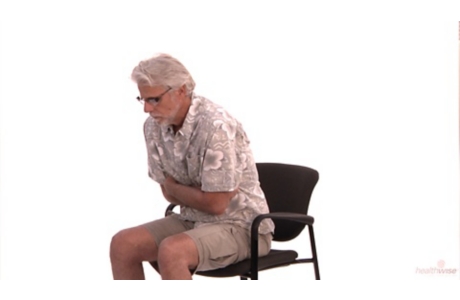Top of the pageActionset
COPD: Clearing Your Lungs
Introduction
COPD (chronic obstructive pulmonary disease) is a long-term illness that makes it hard to breathe. When you have COPD, air does not flow easily into and out of your lungs. You may be short of breath, cough a lot, and have a lot of mucus in your lungs. Learning to clear your lungs may help you save energy and oxygen and may also help prevent lung infections.
There are three things you can do to clear your lungs:
- Controlled coughing. This type of coughing comes from deep in your lungs. It loosens mucus and moves it though your airways.
- Postural drainage. You lie down in different positions to help drain mucus from your lungs.
- Chest percussion. You lightly tap your chest and back. The tapping loosens the mucus in your lungs.
How do you do controlled coughing, postural drainage, and chest percussion?
Controlled coughing
Coughing is how your body tries to get rid of mucus. But the kind of coughing you cannot control makes things worse. It causes your airways to close. It also traps the mucus in your lungs.
Controlled coughing comes from deep in your lungs. It loosens mucus and moves it though your airways. It is best to do it after you use your inhaler or other medicine. Follow these steps for controlled coughing:
- Sit on the edge of a chair, and keep both feet on the floor.
- Lean forward a little, and relax.
- Breathe in slowly through your nose, and fold your arms over your belly.
- As you exhale, lean forward. Push your arms against your belly.
- Cough 2 or 3 times as you exhale with your mouth slightly open. Make the coughs short and sharp. Push on your belly with your arms as you cough. The first cough brings the mucus through the lung airways. The next coughs bring it up and out.
- Inhale again, but do it slowly and gently through your nose. Do not take quick or deep breaths through your mouth. It can block the mucus coming out of the lungs. It also can cause uncontrolled coughing.
- Rest, and repeat if you need to.
Postural drainage
Postural drainage means lying down in different positions to help drain mucus from your lungs.
Hold each position for 5 minutes. Do it about 30 minutes after you use your inhaler. Make sure you have an empty stomach. If you need to cough, sit up and do controlled coughing.
Follow these steps for postural drainage:
- Lie down on a bed or the floor. Use pillows to help you with different positions.
- To drain the front of your lungs
- Lie on your back. Make sure that your chest is lower than your hips. Put two pillows under your hips. Use a small pillow under your head. Keep your arms at your sides.
- Then follow these instructions for breathing: With one hand on your belly and the other on your chest, breathe in. Push your belly out as far as possible. You should be able to feel the hand on your belly move out, while the hand on your chest should not move. When you breathe out, you should be able to feel the hand on your belly move in. This is called belly breathing or diaphragmatic (say “die-uh-fruhg-MAT-ik”) breathing. You will use it in the other drainage positions too.
- To drain the sides of your lungs
- Do this step as you lie on one side. Then turn over, and do it on the other side.
- Place two or three pillows under your hips. Use a small pillow under your head. Make sure your chest is lower than your hips. Use belly breathing. After 5 or 10 minutes, switch sides.
- To drain the back of your lungs
- Lie on your stomach.
- Place two or three pillows under your hips. Use a small pillow under your head.
- Place your arms by your head.
- Use belly breathing.
Chest percussion
Chest percussion means that you lightly tap your chest and back. The tapping loosens the mucus in your lungs.
Follow these steps to do chest percussion:
- Cup your hand, and lightly tap your chest and back.
- Ask your doctor where the best spots are to tap. Avoid your spine and breastbone.
- It may be easier to have someone do the tapping for you.
Credits
Current as of: June 9, 2019
Author: Healthwise Staff
Medical Review:E. Gregory Thompson, MD – Internal Medicine & Adam Husney, MD – Family Medicine & Hasmeena Kathuria, MD – Pulmonology, Critical Care Medicine, Sleep Medicine
Current as of: June 9, 2019
Author: Healthwise Staff
Medical Review:E. Gregory Thompson, MD – Internal Medicine & Adam Husney, MD – Family Medicine & Hasmeena Kathuria, MD – Pulmonology, Critical Care Medicine, Sleep Medicine
This information does not replace the advice of a doctor. Healthwise, Incorporated, disclaims any warranty or liability for your use of this information. Your use of this information means that you agree to the Terms of Use. Learn how we develop our content.





